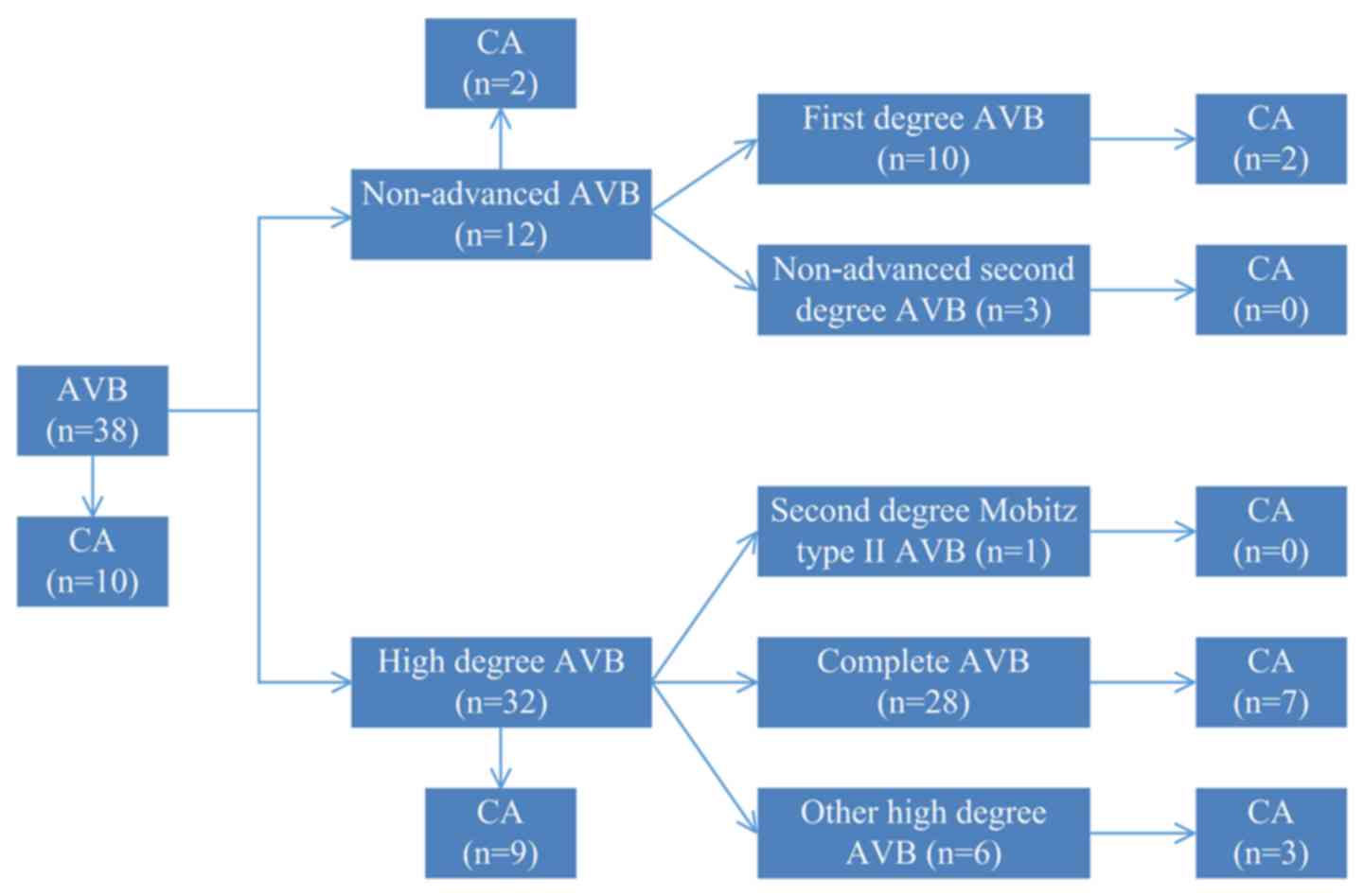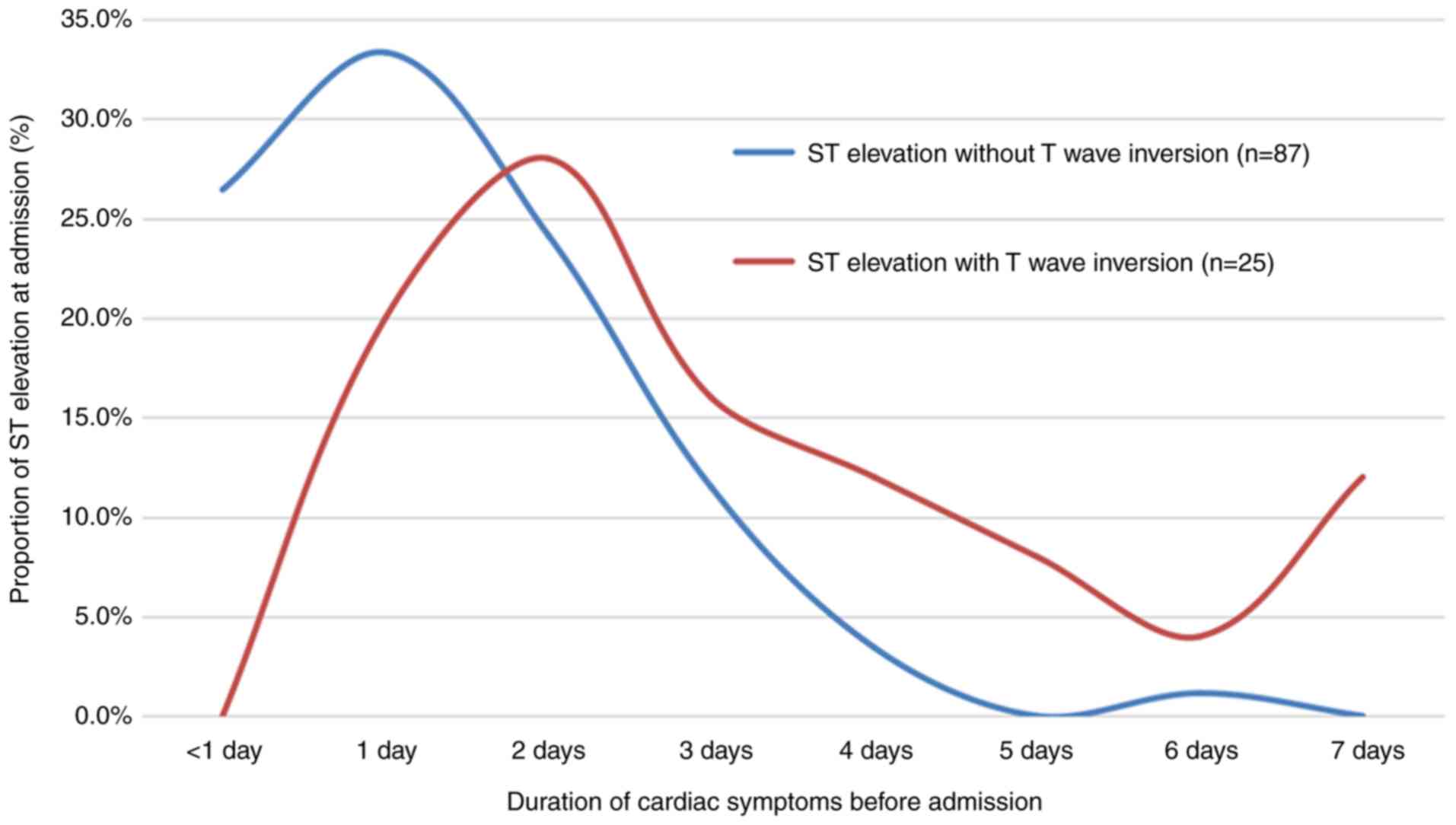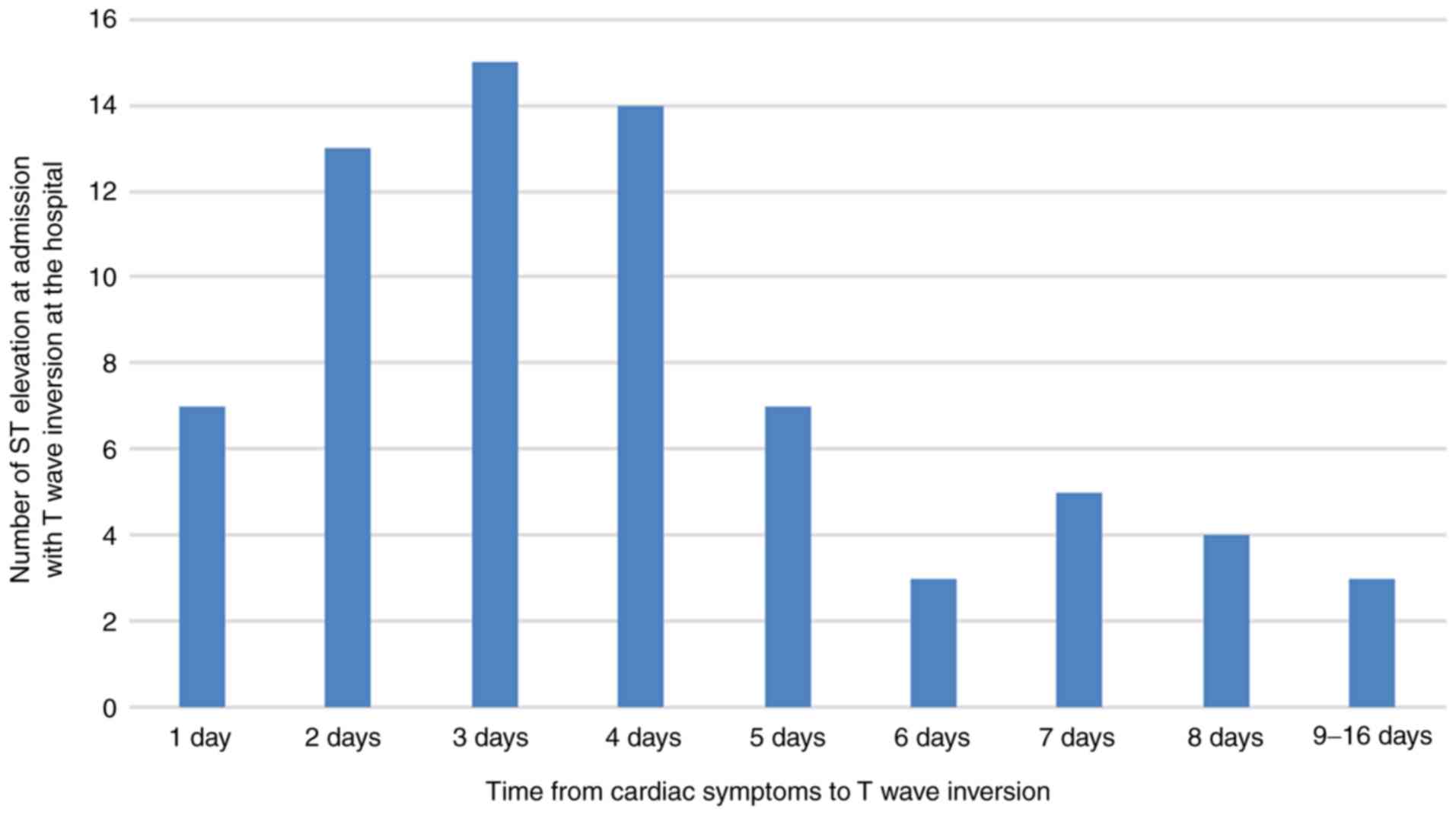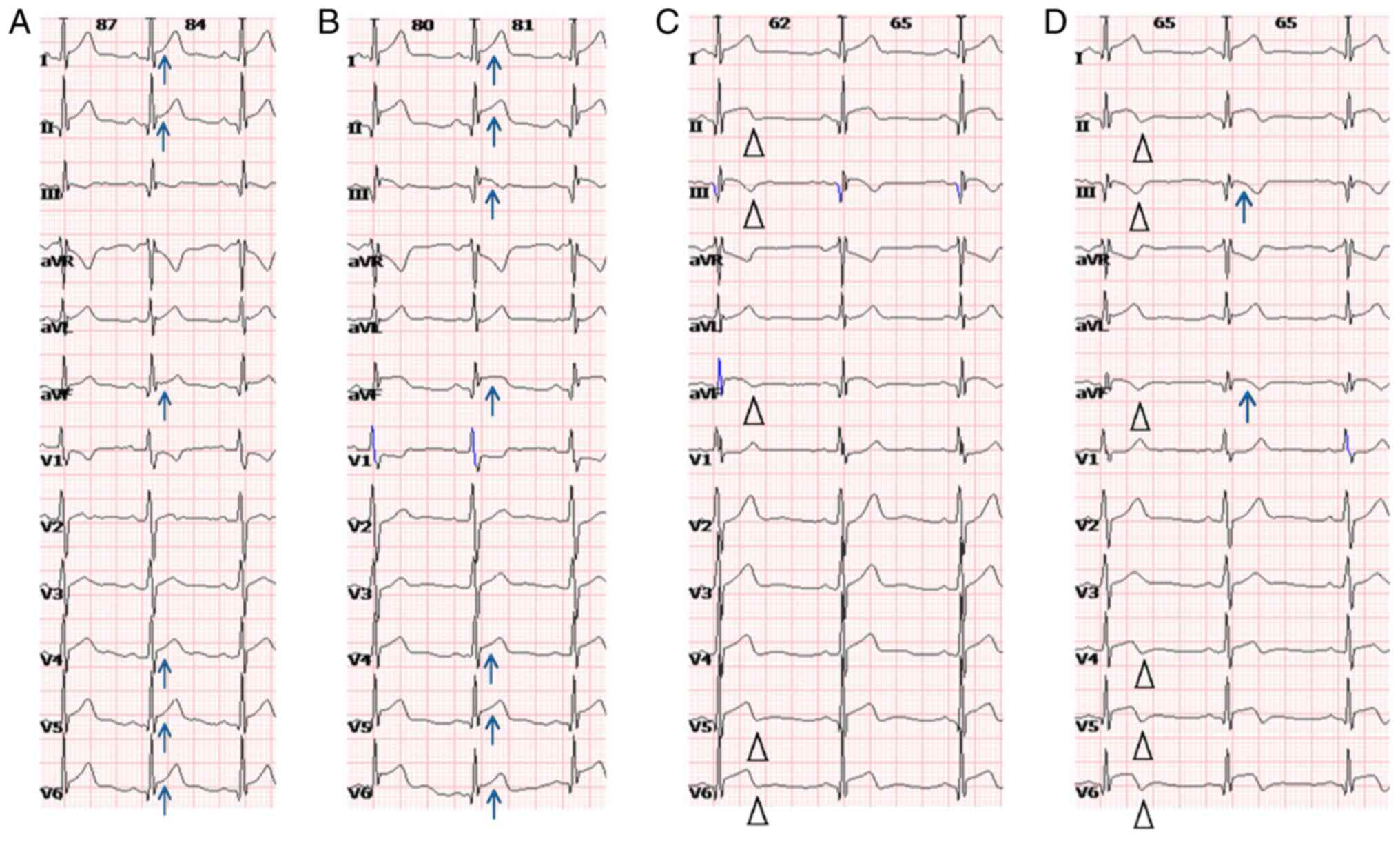|
1
|
Wu S, Yang YM, Zhu J, Wan HB, Wang J,
Zhang H and Shao XH: Clinical characteristics and outcomes of
patients with myocarditis mimicking ST-segment elevation myocardial
infarction: Analysis of a case series. Medicine (Baltimore).
96(e6863)2017.PubMed/NCBI View Article : Google Scholar
|
|
2
|
Caforio AL, Pankuweit S, Arbustini E,
Basso C, Gimeno-Blanes J, Felix SB, Fu M, Heliö T, Heymans S, Jahns
R, et al: Current state of knowledge on aetiology, diagnosis,
management, and therapy of myocarditis: A position statement of the
European society of cardiology working group on myocardial and
pericardial diseases. Eur Heart J. 34:2636–2648, 2648a-2648d.
2013.PubMed/NCBI View Article : Google Scholar
|
|
3
|
Biesbroek PS, Beek AM, Germans T, Niessen
HW and van Rossum AC: Diagnosis of myocarditis: Current state and
future perspectives. Int J Cardiol. 191:211–219. 2015.PubMed/NCBI View Article : Google Scholar
|
|
4
|
Nakashima H, Honda Y and Katayama T:
Serial electrocardiographic findings in acute myocarditis. Intern
Med. 33:659–666. 1994.PubMed/NCBI View Article : Google Scholar
|
|
5
|
Miyake CY, Teele SA, Chen L, Motonaga KS,
Dubin AM, Balasubramanian S, Balise RR, Rosenthal DN, Alexander ME,
Walsh EP and Mah DY: In-hospital arrhythmia development and
outcomes in pediatric patients with acute myocarditis. Am J
Cardiol. 113:535–540. 2014.PubMed/NCBI View Article : Google Scholar
|
|
6
|
Lee KJ, McCrindle BW, Bohn DJ, Wilson GJ,
Taylor GP, Freedom RM, Smallhorn JF and Benson LN: Clinical
outcomes of acute myocarditis in childhood. Heart. 82:226–233.
1999.PubMed/NCBI View Article : Google Scholar
|
|
7
|
Ogunbayo GO, Elayi SC, Ha LD, Olorunfemi
O, Elbadawi A, Saheed D and Sorrell VL: Outcomes of heart block in
myocarditis: A review of 31,760 Patients. Heart Lung Circ.
28:272–276. 2019.PubMed/NCBI View Article : Google Scholar
|
|
8
|
Ukena C, Mahfoud F, Kindermann I, Kandolf
R, Kindermann M and Bohm M: Prognostic electrocardiographic
parameters in patients with suspected myocarditis. Eur J Heart
Fail. 13:398–405. 2011.PubMed/NCBI View Article : Google Scholar
|
|
9
|
Veronese G, Ammirati E, Cipriani M and
Frigerio M: Fulminant myocarditis: Characteristics, treatment, and
outcomes. Anatol J Cardiol. 19:279–286. 2018.PubMed/NCBI View Article : Google Scholar
|
|
10
|
JCS Joint Working Group. Guidelines for
diagnosis and treatment of myocarditis (JCS 2009): Digest version.
Circ J. 75:734–743. 2011.PubMed/NCBI View Article : Google Scholar
|
|
11
|
Baksi AJ, Kanaganayagam GS and Prasad SK:
Arrhythmias in viral myocarditis and pericarditis. Card
Electrophysiol Clin. 7:269–281. 2015.PubMed/NCBI View Article : Google Scholar
|
|
12
|
Ichikawa R, Sumitomo N, Komori A, Abe Y,
Nakamura T, Fukuhara J, Matsumura M, Miyashita M, Kanamaru H,
Ayusawa M and Mugishima H: The follow-up evaluation of
electrocardiogram and arrhythmias in children with fulminant
myocarditis. Circ J. 75:932–938. 2011.PubMed/NCBI View Article : Google Scholar
|
|
13
|
Aretz HT, Billingham ME, Edwards WD,
Factor SM, Fallon JT, Fenoglio JJ Jr, Olsen EG and Schoen FJ:
Myocarditis. A histopathologic definition and classification. Am J
Cardiovasc Pathol. 1:3–14. 1987.PubMed/NCBI
|
|
14
|
Casadonte JR, Mazwi ML, Gambetta KE, Palac
HL, McBride ME, Eltayeb OM, Monge MC, Backer CL and Costello JM:
Risk factors for cardiac arrest or mechanical circulatory support
in children with fulminant myocarditis. Pediatr Cardiol.
38:128–134. 2017.PubMed/NCBI View Article : Google Scholar
|
|
15
|
Ammirati E, Cipriani M, Lilliu M, Sormani
P, Varrenti M, Raineri C, Petrella D, Garascia A, Pedrotti P, Roghi
A, et al: Survival and left ventricular function changes in
fulminant versus nonfulminant acute myocarditis. Circulation.
136:529–545. 2017.PubMed/NCBI View Article : Google Scholar
|
|
16
|
Kligfield P, Gettes LS, Bailey JJ,
Childers R, Deal BJ, Hancock EW, van Herpen G, Kors JA, Macfarlane
P, Mirvis DM, et al: Recommendations for the standardization and
interpretation of the electrocardiogram: Part I: The
electrocardiogram and its technology a scientific statement from
the American heart association electrocardiography and arrhythmias
committee, council on clinical cardiology; the American college of
cardiology foundation; and the heart rhythm society endorsed by the
international society for computerized electrocardiology. J Am Coll
Cardiol. 49:1109–1127. 2007.PubMed/NCBI View Article : Google Scholar
|
|
17
|
Lei YL, Chen SQ, Li ZP, Xue JK, Wang TT,
Zhou ZL, Xu HQ, Lu YR, Li HP, Huang WJ and Cheng JT: Percutaneous
coronary intervention improved outcomes of cardiac arrest after
acute myocardial infarction: A 2-year study. Int J Clin Exp Med.
10:3097–3105. 2017.
|
|
18
|
Rautaharju PM, Surawicz B, Gettes LS,
Bailey JJ, Childers R, Deal BJ, Gorgels A, Hancock EW, Josephson M,
Kligfield P, et al: AHA/ACCF/HRS recommendations for the
standardization and interpretation of the electrocardiogram: Part
IV: The ST segment, T and U waves, and the QT interval: a
scientific statement from the American heart association
electrocardiography and arrhythmias committee, council on clinical
cardiology; the american college of cardiology foundation; and the
heart rhythm society. Endorsed by the international society for
computerized electrocardiology. J Am Coll Cardiol. 53:982–991.
2009.PubMed/NCBI View Article : Google Scholar
|
|
19
|
Al-Khatib SM, Stevenson WG, Ackerman MJ,
Bryant WJ, Callans DJ, Curtis AB, Deal BJ, Dickfeld T, Field ME,
Fonarow GC, et al: 2017 AHA/ACC/HRS guideline for management of
patients with ventricular arrhythmias and the prevention of Sudden
cardiac death: A Report of the American college of
cardiology/American heart association task force on clinical
practice guidelines and the heart rhythm society. Circulation.
138:e272–e391. 2018.PubMed/NCBI View Article : Google Scholar
|
|
20
|
Myerburg RJ, Halperin H, Egan DA, Boineau
R, Chugh SS, Gillis AM, Goldhaber JI, Lathrop DA, Liu P, Niemann
JT, et al: Pulseless electric activity: Definition, causes,
mechanisms, management, and research priorities for the next
decade: Report from a national heart, lung, and blood institute
workshop. Circulation. 128:2532–2541. 2013.PubMed/NCBI View Article : Google Scholar
|
|
21
|
Pavlicek V, Kindermann I, Wintrich J,
Mahfoud F, Klingel K, Böhm M and Ukena C: Ventricular arrhythmias
and myocardial inflammation: Long-term follow-up of patients with
suspected myocarditis. Int J Cardiol. 274:132–137. 2019.PubMed/NCBI View Article : Google Scholar
|
|
22
|
Morgera T, Di Lenarda A, Dreas L,
Pinamonti B, Humar F, Bussani R, Silvestri F, Chersevani D and
Camerini F: Electrocardiography of myocarditis revisited: Clinical
and prognostic significance of electrocardiographic changes. Am
Heart J. 124:455–467. 1992.PubMed/NCBI View Article : Google Scholar
|
|
23
|
Matshela MR: The role of echocardiography
in acute viral myocarditis. Cardiovasc J Afr. 30:239–244.
2019.PubMed/NCBI View Article : Google Scholar
|
|
24
|
Chang YJ, Hsiao HJ, Hsia SH, Lin JJ, Hwang
MS, Chung HT, Chen CL, Huang YC and Tsai MH: Analysis of clinical
parameters and echocardiography as predictors of fatal pediatric
myocarditis. PLoS One. 14(e0214087)2019.PubMed/NCBI View Article : Google Scholar
|


















